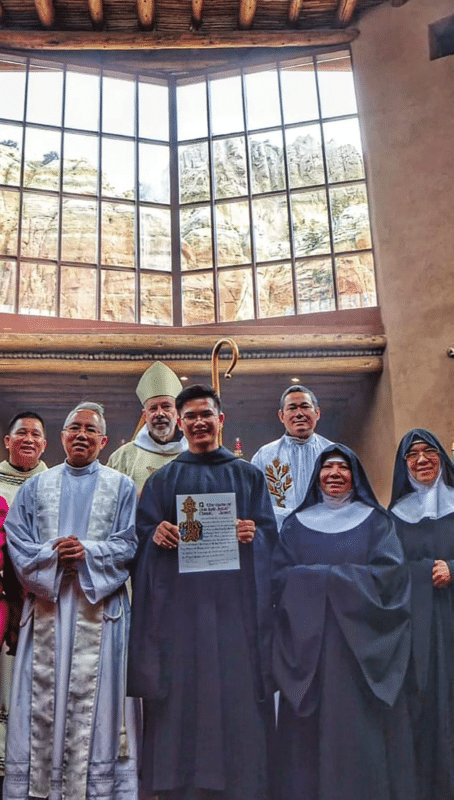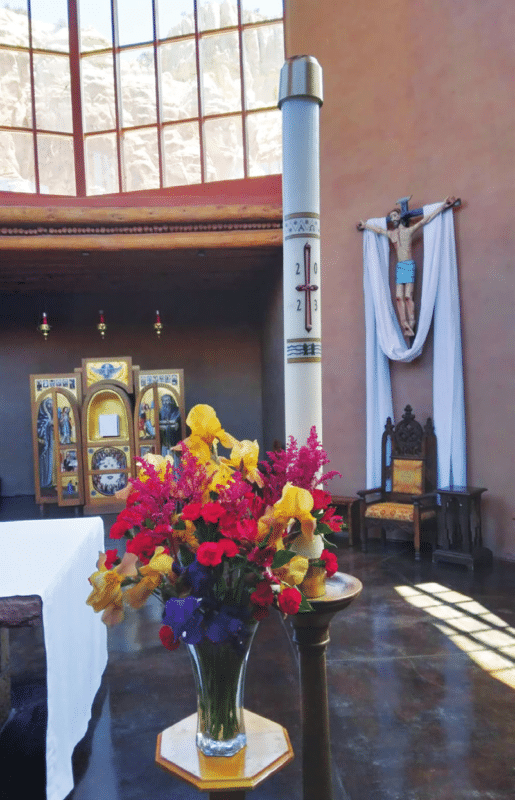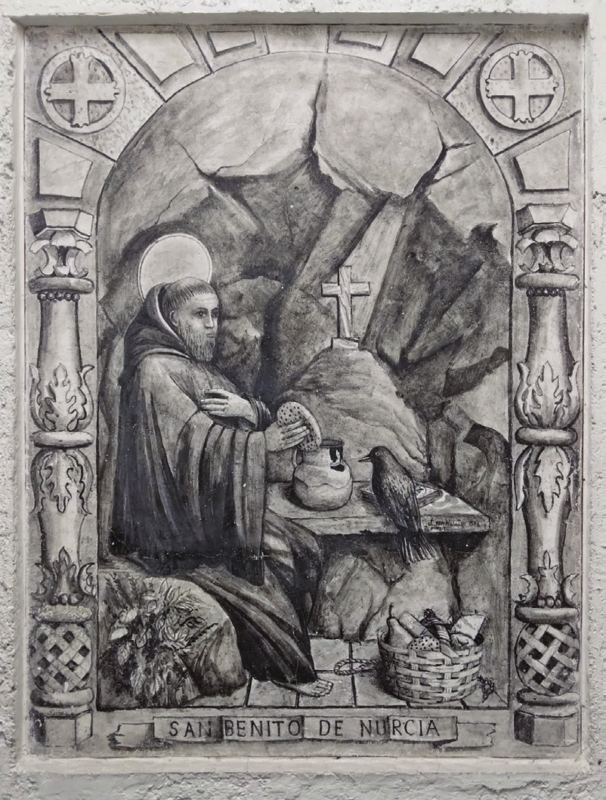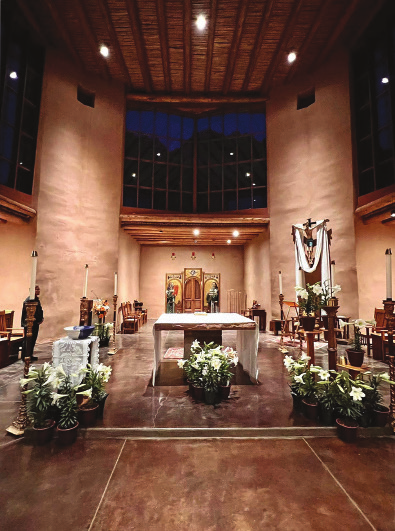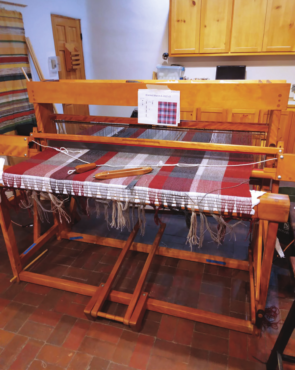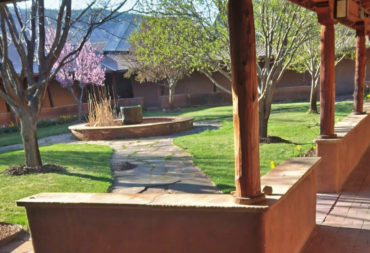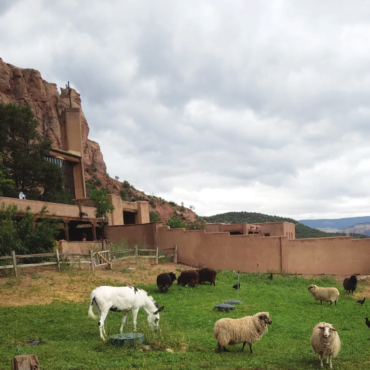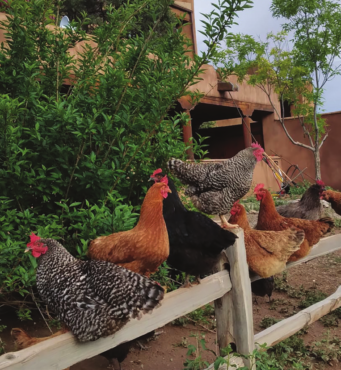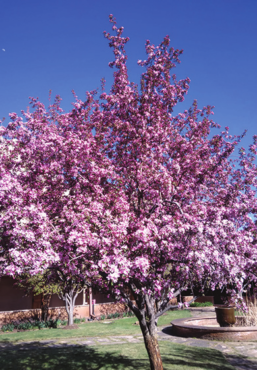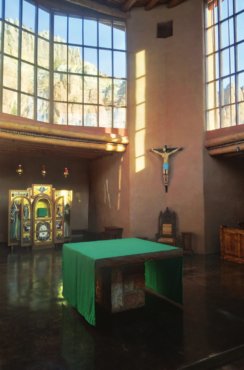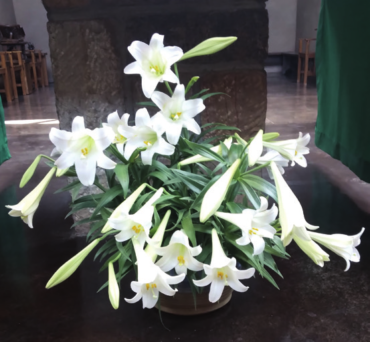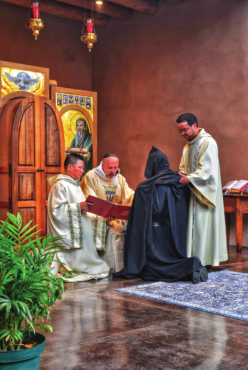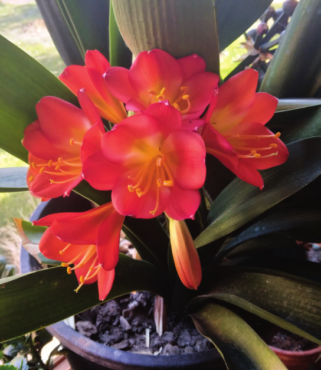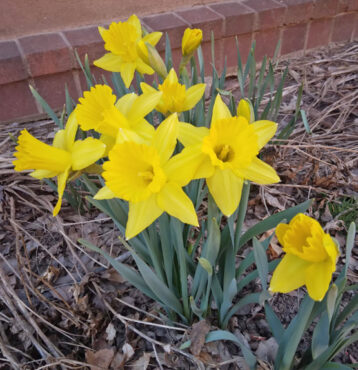FAITH OVER DOUBT
What is doubt? Another word for the concept is uncertainty or unresolved questions. Who of us doesn’t doubt sometimes or often? Questions such as: will my health hold out and will I be able to keep this job if it doesn’t?; how will my children end up?; will I ever reconcile with estranged relatives or friends?, and many more, may pass through our minds on a regular basis.
More profound doubts, such as: does God exist?; is there really a life after this one?; will I make it to heaven if there is an after- life?, may plague us as well. This should be no surprise or cause for alarm, when we have doubts or uncertainties. The bigger question is: what do I do with my doubts?
It should be a consolation that even great saints, such as Therese of Lisieux and Mother Teresa of Calcutta, grappled with serious doubt, yet in the process, never gave up believing that God is stronger than their personal uncertainty. As one anonymous author put it: don’t worry about not being strong enough before you begin. It is on the journey that God makes you strong.
This sentiment is echoed in numerous places in the Bible. Even the Blessed Virgin Mary expressed uncertainty at the Archangel Gabriel’s message that she would bear the Savior of the world. “How can this be?”, Mary asked. And she was given assurance that with God all things are possible.
The world we live in gives us plenty of reason to doubt about so much: the possibility of peace in the Middle East and in the Ukraine, the end of the covid pandemic, the future viability of the very planet we live on. In the face of such doubts and many others, we can understand- ably grow indifferent, bitter, angry or depressed. Yet there needs to be a reminder of the words of the Prophet Isaiah, conveying a crucial message from God: “Do not fear, for I am with you” (Isaiah 41:10).
But is that really enough to make us relax and trust? Maybe not always. However, as believers in a God who desires our good and our partaking of divine life, there needs to be a “leap of faith,” as it is often called, to have confidence that God is guiding the course of human events, even when that may seem far from the case.
Too easily, perhaps, we allow the evil that is evident in the world to prevail over the wider picture; that the majority of people are good, desire what is right and act justly. It is easy to forget this reality and become focused on specific disturbing situations in the world. That doesn’t diminish the seriousness of these situations, but it is so important not to let them overwhelm us.
How might we best do that? First, to cultivate a spirit of optimism rather than pessimism. This could be done, for example, by dedicating a period of time every day, a few minutes or longer, to praying specially for the conflicts and ills of our times, for God’s intervention to bring about a change of heart in those who are in armed conflict, or enlightenment for those trying to find solutions to disease and famine. That may seem like a feeble or even futile exercise, but as people of faith we believe in the power of prayer and should always be willing to engage in it.
Another important exercise might be to refrain from over-indulging in the media that is so focused on the ills of the world, rather than on all the goodness that exists. We all need examples of people and situations that en- courage and edify us in the common pilgrimage that we make from the cradle to the end of our earthly existence. Let’s look for those examples!
I recall being really uplifted by the 2000 documentary “Young at Heart: You’re Never Too Old to Rock,” about a Massachusetts-based choir composed of seniors (seventy and older I would qualify!), who were deeply dedicated
to bringing joy to others by their sung concerts of a wide variety of music. The film was funny and deeply encouraging at the same time. Would that all of us might be as enthusiastic as these elders in what they were doing, what we could even call “something beautiful for God”. Even if not specifically a “religious choir” by any means, the Young at Heart chorus was and is the embodiment of the words of Saint John Chrysostom that I often like to quote: “Glory be to God for all things!”
Yes, in our day and age there is plenty to “get us down,” to cause us to question the worth of living or hoping, but we are being called to resist the pessimism and promote the good, because we are people of faith. The old saying, “Better to light one candle than to curse the darkness” should never be far from our thoughts and practice, as we move through life, in good times and bad. We must place our trust in God and do our best to be people of faith, rather than of unbelief. May God help us in that vital work.
The theme of this Newsletter is “Faith Over Doubt”. May the words you read be cause for having faith and encourage you on your pilgrim way.
Abbot Christian Leisy, OSB
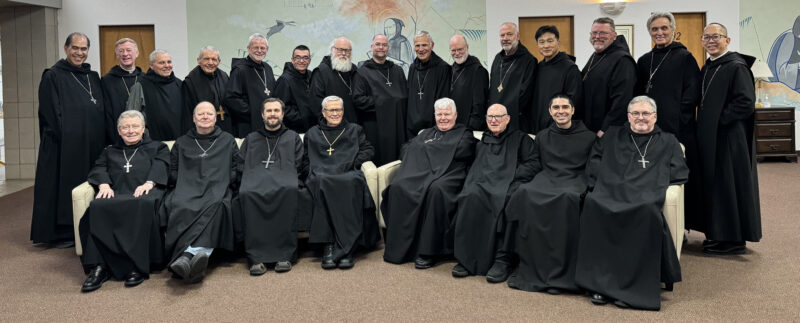
Abbot Christian with Other North American Abbots at Their Annual Meeting in February, this Year at Prince of Peace Abbey, Oceanside, California
DECEMBER 8TH: NEWLY PROFESSED BROTHER SAVIO
By Abbot Christian
Solemn vows of obedience, stability and conversion of life, and receiving the monastic consecration as a Benedictine monk, on the Solemnity of the Immaculate Conception, 2023.
In addition to his monastic community, a number of friends were also present for the Conventual Mass of Monastic Profession on December 8th at 11:00 am.
Distinguished guests included Brother Savio’s uncle, Father Benoit Vu, pastor of the parish of Saint Joseph in Springer, New Mexico, approximately four hours from us.
Only an hour away is the parish of San Juan Nepomuceno in El Rito, New Mexico, whose pastor, Father Joseph Dao, was present too. El Rito is the location of a medical and dental clinic that we regularly visit.
After the 11:00 am Mass, lasting about an hour and a half, at approximately 1:15 pm we enjoyed a splendid Vietnamese meal prepared by our Brothers John Baptist, Martino and Prior Bonaventure, as well as oblates Tom and Angie Nguyen.
We rejoice in the continued growth of our monastic community and for Brother Savio’s commitment, and appreciate your prayers for Brother Savio, for all his needs and intentions
CELEBRATING THE LITURGY
By Abbot Christian
For the last few centuries, at least in Europe and the Americas, Catholics have opted to sing what we call “hymns” at Sunday and daily Mass (the Eucharist). The texts of the hymns are sometimes from the Bible, but not always, and the melodies are often familiar tunes (frequently of German or French origin), or else original musical compositions, by Catholic and non-Catholic musicians. Singing a hymn at the begin- ning of Mass, as well as at the Offertory, Communion and conclusion of Mass, has become the staple of what is “sung at Mass,” rain or shine. While hymns at Mass are not forbidden, the Church is actually asking something else of the faithful.
For centuries the Church has assigned specific Bible texts to accompany the Entrance (also called the “Introit”), the Offertory and the Communion at every Mass. Especially since Vatican II, with its emphasis on Catholics knowing the Bible better, these Scripture texts have been deemed to be the most appropriate words for the various moments at Mass.
Today chant-based music is provided in the Roman Missal for the various English words of the priest and the people at Mass, but no music is provided for the Entrance, Offertory and Communion texts, or “antiphons,” as they are officially called.
Is there a resource available for singing at Mass using the biblical texts assigned by the Church?
At Christ in the Desert we have found the answer to that question in the work of the Benedictine Father Samuel Weber, a monk of Saint Meinrad Archabbey in Indiana. Father Samuel has taken the official English texts from the Roman Missal for every Sunday and weekday, as well as for Solemnities and Feasts and Seasons of the Church throughout the year (Advent, Christmas, Lent, Easter), and adapted traditional Gregorian chant melodies to the Entrance, Offertory and Communion antiphons.
Father Samuel’s work is a boon to our monastic liturgy, and is also used at numerous English-speaking parish Masses, and by other religious communities as well. Father Samuel’s 2010, The Proper of the Mass for Sundays and Solemnities: Chants for the Roman
Missal in English, is our “go to” resource for Ordinary Time and Solemnity Masses. This handsomely produced volume is available in the USA through Ignatius Press.
Father Samuel has completed two other valuable volumes of Mass music, one which covers each special Season of the Liturgical Year, that is, Advent and Christmastide, Lent and Eastertide, and the second volume for the Saints of the Church. A fourth volume also exists, for Votive (Ritual) Masses. These volumes are available at Father Samuel’s website: Sacredmusicus.Wordpress.com
Along with Father Samuel’s Mass books that we use each day (just one of his volumes is needed for any given day), we also use the slim volume, called the Kyriale, from the Benedictine Abbey of Solesmes in France, with every Kyrie (Lord, have mercy), Sanctus (Holy, Holy) and Agnus Dei (Lamb of God) needed each day, as well as the Gloria (Gloria to God) and Credo (the Creed), which are used on Sundays, Feasts and Solemnities. The Kyriale is available for purchase through GIA Publications (Gregorian Institute of America), in Chicago.
We are very indebted to Father Samuel Weber for the noble simplicity of his work, which enhances our celebration of the Mass each day.
DOUBT IS ALWAYS THERE
Short Fiction
By Brother Chrysostom
Spring semester 2009 would decide her future in the department. Hannah Walsh struggled in the History Department as an instructor for the past three years. Her student evaluations improved, but she failed to attract numbers of students for larger class sizes— what tenured professors like Professor Sterling- White did effortlessly. Her fellow untenured col- leagues encouraged her. She appreciated their esprit de corps, especially from Br. Placid and Dr. Stigler, both medievalists new to the history department.
Sadly, she could pull in neither the number of students nor the high evaluations that would strengthen her case for a tenure-track position at Benedictus College, nestled amongst the cornfields and storied golf courses of southern Pennsylvania.
Her opportunity for redemption came astoundingly. Br. Enoch, an éminence grise in the Traditions of Monasticism Department at the college, had to take a leave of absence due to an unexpected appendectomy. Were he a younger monk, say 60, he might have recovered in time to start and complete the spring course. But Br. Enoch was a strapping 87, spry, yes, but not as resilient as he used to be when monks filled the choirs in the vast university church and numbered in the 400’s decades ago.
Because the other professors in the department were juggling heavy course-loads, while some were scheduled to teach at St. Victor College in North Dakota, they chose Dr. Hannah Walsh, reluctantly, to pull up the slack and teach the Introduction to Monasticism 101 course that many freshmen took in their second semester, along with a sprinkling of some upper classmen who needed a ‘filler’ class to complete a graduation requirement. The department heads in History and Theology agreed to give the struggling Dr. Walsh a shot at a popular class.
Having little time to prepare a syllabus, she borrowed Br. Enoch’s with the permission of Dr. Stanton, her department head. She tried to make the course offering enticing, at least to herself first, but the story of monastic traditions starting with Simeon and Anna, then moving onto the Desert Fathers, then to Saint Benedict’s life and to the great monasteries of Europe, Charlemagne and the Frankish Empire, Cîteaux Abbey, the Abbeys of Montecassino, Cluny, and Mont St. Michel seemed dry and lifeless to her. How would she bring these great monasteries and their famous abbots to life for freshmen whose main goal in class would be to ‘like’ on social media the most sensational clip from last weekend’s dorm party? She needed a hook.
Three days before the commencement of the spring semester the hook came to her: a concluding field trip to the Met Cloisters Museum in Manhattan. She hadn’t had time to add it to the syllabus she submit- ted online weeks ago, so she thought it would be the first reveal of the new semester.
Only five students populated the small classroom assigned to her for the class. Not enough to make a class, in the judgment of Fr. Butler, the Provost. Tenure was not to be, she thought. She was about to dismiss the class, thinking it would be cancelled, when Earl, a senior pre-med, sauntered into class and sat down in one of the desks in the back. His grey plain shirt with white long underwear peeping above the collar, faded blue jeans, unlaced Timber-
land boots with fleece lining, disheveled hair tucked quickly under a tight black skull-cap announced to the five freshmen the return of the ‘king’. Hannah quickly went over the syllabus with the six students required to make the class. She mustered as much enthusiasm for the subject matter as she possibly could, and near the end of class, with raised hands, gave the announcement about the field trip to the Met Cloisters at the end of the semester. The freshmen looked up from their laptops—and social media—and stared at Hannah in joyous disbelief. Even King Earl lifted his drowsy head from a quick catnap to think about the proposition: a day trip to the Big Apple.
Oh, yeah!
The semester passed quickly. Hannah discovered early on that she really learned a subject when she had to teach it. Hannah became engrossed in monastic traditions and history; her students’ interest was ignited by her curiosity. The accounts of Guillaume Marlot and the construction of the Rheims Cathedral; double monasteries such as Barking Abbey, which followed the Gallic tradition of separation of the sexes with one exception: under Hildelith, abbess of Barking, both monk and nun burials were combined into a single mass grave. And, of course, the juggernaut Abbey of Cluny, which created a large, federated order in competition with the order of kingdoms in their day. Readings from Henry Adams’ Mont Saint Michel and Chartres stoked the romantic appetites of the eager freshmen, Josie, Charles, Brittany, Marie, and Mark for the architecture they would be experiencing at the end of the semester on the field trip. Hannah could not believe, in spite of her rocky start with the department, that she was actually getting paid to teach this wonderful course!
King Earl turned his nose up at the enthusiasm of his teacher and her acolytes. He never bestowed upon a class discussion the gift of his opinions. He exiled himself from most classes and abdicated on most assignments. He reclined in the back of the class room, his long legs finding ample space to stretch between two desks in the penultimate row. When he did present himself, like a force of nature, the mousy freshmen would become muted, as if they were afraid that he would ruin gaiety because it did not include him or was not sanctioned by him. Minutes into class after his auspicious appear- ance, Hannah would draw the focus back to herself and the course material, and the learning would resume.
King Earl, however, for the field trip did find his way into the school van that they would drive to New York City
at the monastic hour of 4:00 am. Over a morning, rural Pennsylvania changed into rural New York, and changed again into urban New York City. They arrived at the Met Cloisters in Washington Heights in Upper Manhattan, over- looking the Hudson River. The museum featured parts of several European monasteries, which had been dismantled, transported, and rebuilt in New York. Frescoes, tapestries, sculptures, stained glass, and religious images evoked the spirit of the medieval monasteries reconstructed at the end of the A train line.
After lunch and a few hours to explore the museum, the trip was deemed an undeniable success. The students talked about it most of the way back during the drive to campus. King Earl at shotgun in the van and driver Han- nah found themselves the only passengers awake during the last two hundred or so miles from campus. King Earl seemed moved by the experience, but Hannah had difficulty believing his interest, given his egregious absences and slapdash work. When she found the courage to ask him about the disconnect between his behavior and his apparent interest in the subject matter, he simply pulled his black skull-cap down over his eyes and proclaimed through a melodramatic sigh:
“Healthy doubt, Prof. Hannah. You can’t always believe what you see,” King Earl said.
During final exams week and after impassioned cajoling from King Earl, she allowed him to take the final exam, although he should have failed the class on attendance alone. He needed to pass the course. She needed his evaluation, moreover, to make this course and raise her stock in the eyes of the department.
The evaluations were proctored after the final exam on the fol- lowing class. King Earl was absent from class. The class did not make with only five evaluations, despite the praises of her cherubic freshmen. She dolefully graded the final exams and submitted her final grades, which she thought might indeed be her final grades at that college. She gave King Earl a passing grade so as not to dash his medical-school aspirations. She had no expectations of returning to teach at the college the next semester.
It is Spring Semester 2018. Professor Hannah reaches into her mailbox in the department mailroom, where hers is above those of the newly hired instructors in the department. She walks a short distance from the mailroom to her spacious office with a window facing the quad and the rural Pennsylvanian farmland.
It is a beautiful spring afternoon and the sun strikes her face with an intensity that holds her in a calm bliss as she sinks into her high-back chair behind her large desk. She ruffles through the interdepartmental mail, publishing-house junk mail, and errant announcements for upcoming lectures, and finds the postcard.
She extracts the card and lays the balance of the mail upon her recently received Fr. Erskine Touhy Award for Outstanding Classroom Teaching and Student Engagement. The photo side is of some ancient monastic cloister hallway she doesn’t recognize. She turns the card over and reads the regal script:
Hey, Prof. Hannah,
My wife, new daughter, our parents, and I had a great visit to the Cloisters. I remember you brought me here first!
Best, Earl Crammer, M.D.
60TH ANNIVERSARY OF THE MONASTERY
This year marks the 60th anniversary of the founding of the Monastery of Christ in the Desert, which took place on June 24th, 1964.
On that day our founding Prior, Father Aelred Wall, and co-founders Fathers Placid Cormey and Basil DePinto inaugurated monastic life in the Chama Canyon wilderness of Northern New Mexico.
We are grateful beyond words for the foresight and courage of the monks who began our monastery and who laid the groundwork for future generations of monks, retreatants and day visitors to come to this place we call home, where we strive to glorify God in our daily round of Benedictine monastic life.
Each day at Mass we pray for those who have “gone before us marked with the sign of faith,” that is, all the Faithful Departed. These include two of our founders (Father Basil DePinto is still alive!), as well as others who have been members of our community in the past.
These and many other family members, friends, benefactors and oblates have assisted in keeping our Monastery afloat, where we aim at implementing the words of Saint Benedict: “Let them prefer nothing whatever to Christ.” ✠

